True/False
Indicate whether the
sentence or statement is true or false.
|
|
|
1.
|
The Phillips curve illustrates the positive
relationship between inflation and unemployment.
|
|
|
2.
|
If inflation is 4 per cent and unemployment is 6
per cent, the misery index is 2 per cent.
|
|
|
3.
|
In the short run, an increase in aggregate demand
increases prices and output, and decreases unemployment.
|
|
|
4.
|
When unemployment is below the natural rate the
labour market is unusually tight, putting pressure on wages and prices to rise.
|
|
|
5.
|
An increase in price expectations shifts the
Phillips curve upward and makes the inflation unemployment trade-off less favourable.
|
|
|
6.
|
An increase in the money supply increases inflation
and permanently decreases unemployment.
|
|
|
7.
|
In the long run, the unemployment rate is
independent of inflation and the Phillips curve is vertical at the natural rate of
unemployment.
|
|
|
8.
|
When actual inflation exceeds expected inflation,
unemployment exceeds the natural rate.
|
|
|
9.
|
The natural rate hypothesis suggests that, in the
long run, unemployment returns to its natural rate, regardless of inflation.
|
|
|
10.
|
An adverse supply shock, such as an increase in the
price of imported oil, shifts the Phillips curve upward and makes the inflation unemployment
trade-off less favourable.
|
|
|
11.
|
A decrease in unemployment benefits reduces the
natural rate of unemployment and shifts the long-run Phillips curve to the right.
|
|
|
12.
|
An increase in aggregate demand temporarily reduces
unemployment, but after people raise their expectations of inflation, unemployment returns to the
natural rate.
|
|
|
13.
|
A sudden monetary contraction moves the economy up
a short-run Phillips curve, reducing unemployment and increasing inflation.
|
|
|
14.
|
If people have rational expectations, an announced
monetary contraction by the central bank that is credible could reduce inflation with little or no
increase in unemployment.
|
|
|
15.
|
If the sacrifice ratio is four, a reduction of
inflation from 9 per cent to 5 per cent requires a reduction in output of 8 per cent.
|
Multiple Choice
Identify the
letter of the choice that best completes the statement or answers the question.
|
|
|
16.
|
The misery index, which some commentators suggest
measures the health of the economy, is
a. | the sum of the growth rate of output and the inflation
rate. | b. | the sum of the natural rate of unemployment and the
actual rate of unemployment. | c. | the sum of the
inflation rate and the central bank’s refinancing rate. | d. | the sum of the unemployment rate and the inflation
rate. |
|
|
|
17.
|
The original Phillips curve
illustrates
a. | the trade-off between inflation and
unemployment. | b. | the trade-off
between output and unemployment. | c. | the positive
relationship between output and unemployment. | d. | the positive
relationship between inflation and unemployment. |
|
|
|
18.
|
The Phillips curve is an extension of the model of
aggregate supply and aggregate demand because, in the short run, an increase in aggregate demand
increases prices and
a. | decreases unemployment. | b. | decreases growth. | c. | increases
unemployment. | d. | decreases
inflation. |
|
|
|
19.
|
Along a short-run Phillips curve,
a. | a higher rate of inflation is associated with a lower
unemployment rate. | b. | a higher rate of
growth in output is associated with a lower unemployment rate. | c. | a higher rate of inflation is associated with a higher unemployment
rate. | d. | a higher rate of growth in output is associated with a
higher unemployment rate. |
|
|
|
20.
|
If, in the long run, people adjust their price
expectations so that all prices and incomes move proportionately to an increase in the price level,
then the long-run Phillips curve
a. | is vertical. | b. | is negatively sloped. | c. | has a slope that
is determined by how fast people adjust their price expectations. | d. | is positively sloped. |
|
|
|
21.
|
According to the Phillips curve, in the short run,
if policy makers choose an expansionary policy to lower the rate of unemployment,
a. | the economy will experience an increase in
inflation. | b. | the economy will
experience a decrease in inflation. | c. | inflation will be
unaffected if price expectations are unchanging. | d. | none of these answers |
|
|
|
22.
|
An increase in expected inflation
a. | shifts the short-run Phillips curve downward and the
unemployment inflation trade-off is less favourable. | b. | shifts the short-run Phillips curve upward and the unemployment inflation
trade-off is more favourable. | c. | shifts the
short-run Phillips curve downward and the unemployment inflation trade-off is more
favourable. | d. | shifts the
short-run Phillips curve upward and the unemployment inflation trade-off is less
favourable. |
|
|
|
23.
|
Which of the following would shift the long-run
Phillips curve to the right?
a. | An increase in the minimum
wage | b. | An increase in expected
inflation | c. | An increase in the price of foreign
oil | d. | An increase in aggregate
demand |
|
|
|
24.
|
When actual inflation exceeds expected
inflation,
a. | unemployment is equal to the natural rate of
unemployment. | b. | people will reduce
their expectations of inflation in the future. | c. | unemployment is
greater than the natural rate of unemployment. | d. | unemployment is
less than the natural rate of unemployment. |
|
|
|
25.
|
A decrease the price of foreign oil
a. | shifts the short-run Phillips curve downward, and makes
the unemployment inflation trade-off less favourable. | b. | shifts the short-run Phillips curve upward, and makes the unemployment
inflation trade-off less favourable. | c. | shifts the
short-run Phillips curve upward, and makes the unemployment inflation trade-off more
favourable. | d. | shifts the
short-run Phillips curve downward, and makes the unemployment inflation trade-off more
favourable. |
|
|
|
26.
|
The natural rate hypothesis argues
that
a. | in the long run, the unemployment rate returns to the
natural rate, regardless of inflation. | b. | unemployment is
always below the natural rate. | c. | unemployment is
always above the natural rate. | d. | unemployment is
always equal to the natural rate. |
|
|
|
27.
|
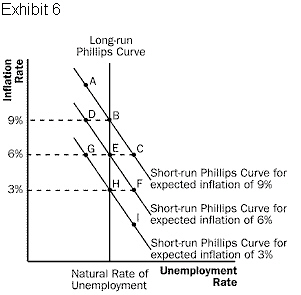
Refer to Exhibit 6. If people in
the economy expect inflation to be 3 per cent and inflation is 3 per cent, the economy is operating
at point
|
|
|
28.
|
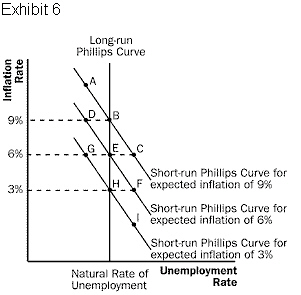 Refer to Exhibit 6. If people in the economy expect inflation to be 6 per cent
but inflation turns out to be 3 per cent, the economy is operating at point Refer to Exhibit 6. If people in the economy expect inflation to be 6 per cent
but inflation turns out to be 3 per cent, the economy is operating at point
|
|
|
29.
|
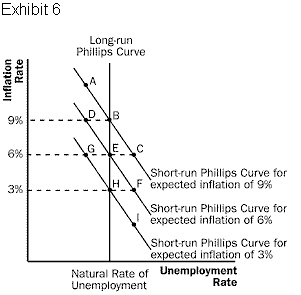
Refer to Exhibit 6. Suppose the economy is in long-run equilibrium at
point E. A sudden increase in government spending should move the economy in the direction of
point
|
|
|
30.
|
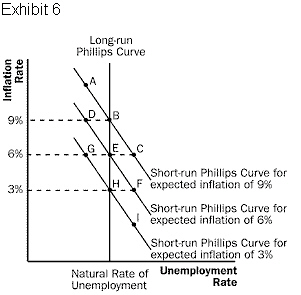 Refer to Exhibit 6. Suppose the economy is operating at point D. As people
revise their price expectations, Refer to Exhibit 6. Suppose the economy is operating at point D. As people
revise their price expectations,a. | the short-run Phillips curve will shift in the direction
of the short-run Phillips curve associated with an expectation of 3 per cent
inflation. | b. | the short-run
Phillips curve will shift in the direction of the short-run Phillips curve associated with an
expectation of 9 per cent inflation. | c. | the short-run
Phillips curve will shift in the direction of the short-run Phillips curve associated with an
expectation of 6 per cent inflation. | d. | the long-run
Phillips curve will shift to the left. |
|
|
|
31.
|
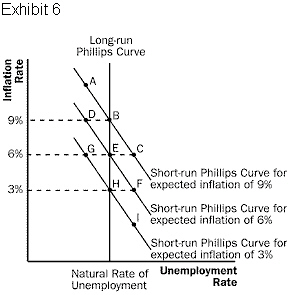 Refer to Exhibit 6. Suppose the economy is operating in long-run equilibrium
at point E. An unexpected monetary contraction will move the economy in the direction of
point Refer to Exhibit 6. Suppose the economy is operating in long-run equilibrium
at point E. An unexpected monetary contraction will move the economy in the direction of
point
|
|
|
32.
|
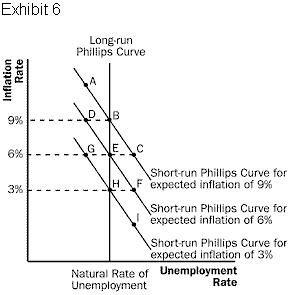 Refer to Exhibit 6. Suppose the economy is operating in long-run equilibrium
at point E. In the long run, a monetary contraction will move the economy in the direction of
point Refer to Exhibit 6. Suppose the economy is operating in long-run equilibrium
at point E. In the long run, a monetary contraction will move the economy in the direction of
point
|
|
|
33.
|
If people have rational expectations, a monetary
policy contraction that is announced and is credible could
a. | reduce inflation with little or no increase in
unemployment. | b. | increase inflation
but it would decrease unemployment by an unusually large amount. | c. | increase inflation with little or no decrease in
unemployment. | d. | reduce inflation
but it would increase unemployment by an unusually large
amount. |
|
|
|
34.
|
If the sacrifice ratio is five, a reduction in
inflation from 7 per cent to 3 per cent would require
a. | a reduction in output of 20 per
cent. | b. | a reduction in output of 5 per
cent. | c. | a reduction in output of 15 per
cent. | d. | a reduction in output of 35 per
cent. |
|
|
|
35.
|
If a country’s policy makers were to
continuously use expansionary monetary policy in an attempt to hold unemployment below the natural
rate, the long-run result would be
a. | an increase in the level of
output. | b. | a decrease in the unemployment
rate. | c. | an increase in the rate of
inflation. | d. | all of these
answers. |
|